Dragon Age: Inquisition Review
A captivating adventure with monumental world design and deep characters
BioWare has created some wonderful character-driven role playing games in recent times. Their Mass Effect series gained critical acclaim with intriguing companions and a fully-realised sci-fi tale about saving the galaxy. Dragon Age: Origins had brilliant characters and gave players control over their fate in the fantasy land of Thedas. Despite being excellent games, they were not perfect. Mass Effect’s ending was unjustly brief and its combat often average. Dragon Age: Origins suffered monotony due to the sheer volume of combat encounters, and that was before the Deep Roads. But in both of these cases, it was the story and characters that elevated them into a higher tier. Dragon Age: Inquisition is also not perfect, yet its characters and world produce a grandiose adventure that is worth experiencing.
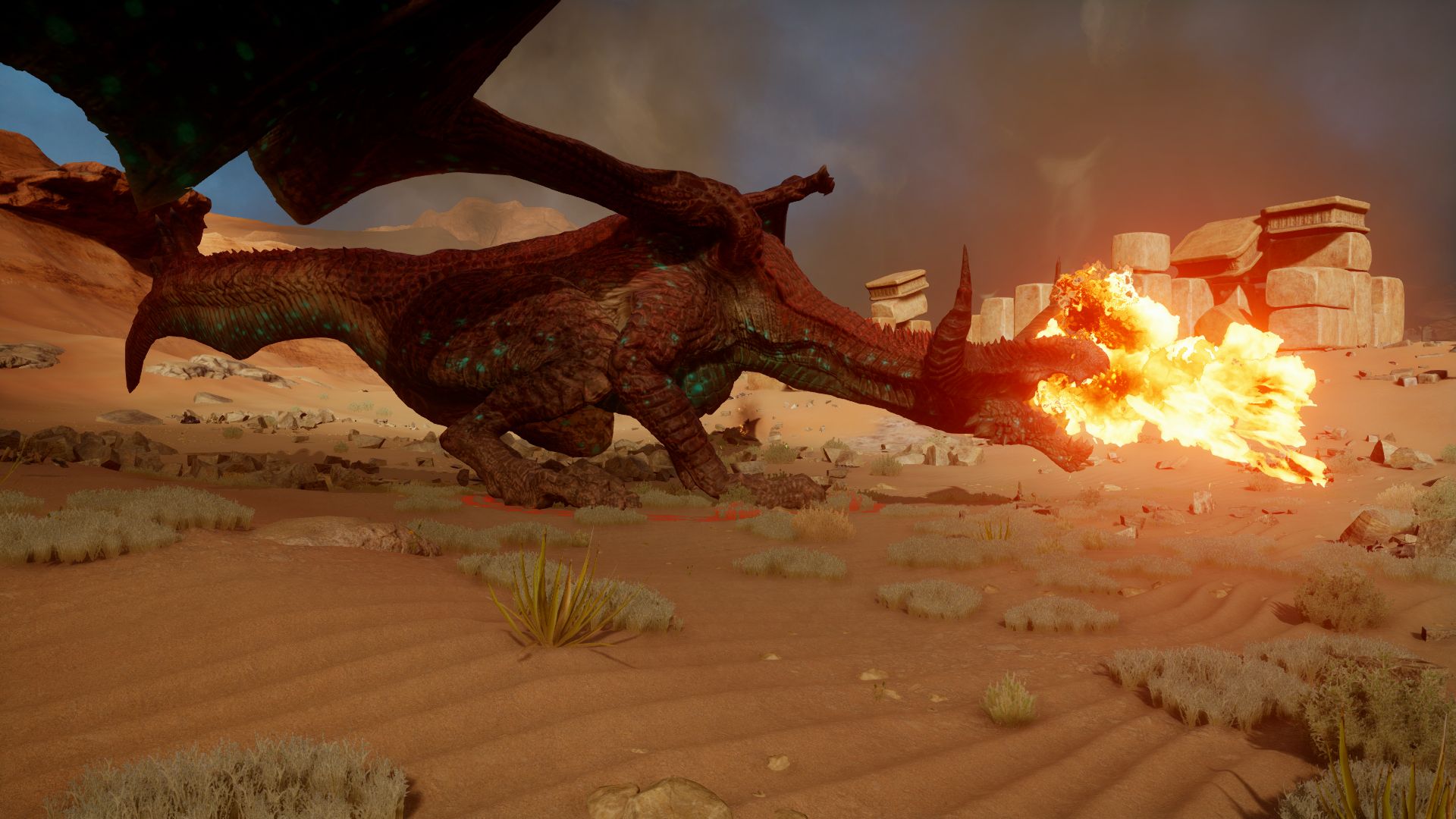
Dragons are back at the top of the food chain, and so is BioWare
Players begin their journey as the sole survivor of a massive explosion that kills Divine Justinia, head of the Chantry religion in Thedas. This explosion opens a dimensional rift to the Fade, allowing demons to enter the world and generate chaos across the land. You have not survived the explosion unscathed, as your hand now bares a mark that can close Fade rifts. With the Chantry in chaos, a small group forms an Inquisition to defend the world from this threat until order is restored. You become an integral part of this Inquisition and use the mark to restore order. Soon, word of your achievements spreads and you become a religious inspiration for the displaced people of Thedas. As you overcome challenges and make crucial decisions, you become leader of the inquisition. As Inquisitor, the fate of the world is in your hands.
The narrative of this sequel successfully exploits themes from its predecessors while forging its own path. The returning themes include the Grey Wardens and the feud between the Mages and Templars. Faith plays a key role and character responses will have you questioning your stance on numerous subjects. Old characters return, depending on the world state imported from Dragon Age Keep, and key decisions will shape the story. These difficult choices may kill characters or change the allies that join the inquisition. With a different starting world state and branching choices, there is compelling reason to replay the game. Although given the length of the campaign, you may not have the time.
Dragon Age: Inquisition has massive scope, both in world design and narrative. This is not a contiguous open world game like Skyrim, yet it draws heavy inspiration from Bethesda’s masterpiece. Dragon Age: Inquisition has enormous, unique zones that can be explored freely between the lengthy story missions. Most zones are not required to be explored for the main story although they are often part of companion quests. You will be overwhelmed with objectives, but never pressured for time. The zones are repopulated with wildlife and enemies each time you return, and the respawning changes based on your actions. Enemies linked to quests will scale to provide challenge should you revisit earlier areas. As you progress, additional quests are added to zones and you can venture into regions with tougher enemies. Outside these open zones, you will interact with characters and undertake hand-crafted story missions. This framework plays to the strengths of BioWare, and gives the player control over an open adventure that is thick with narrative.
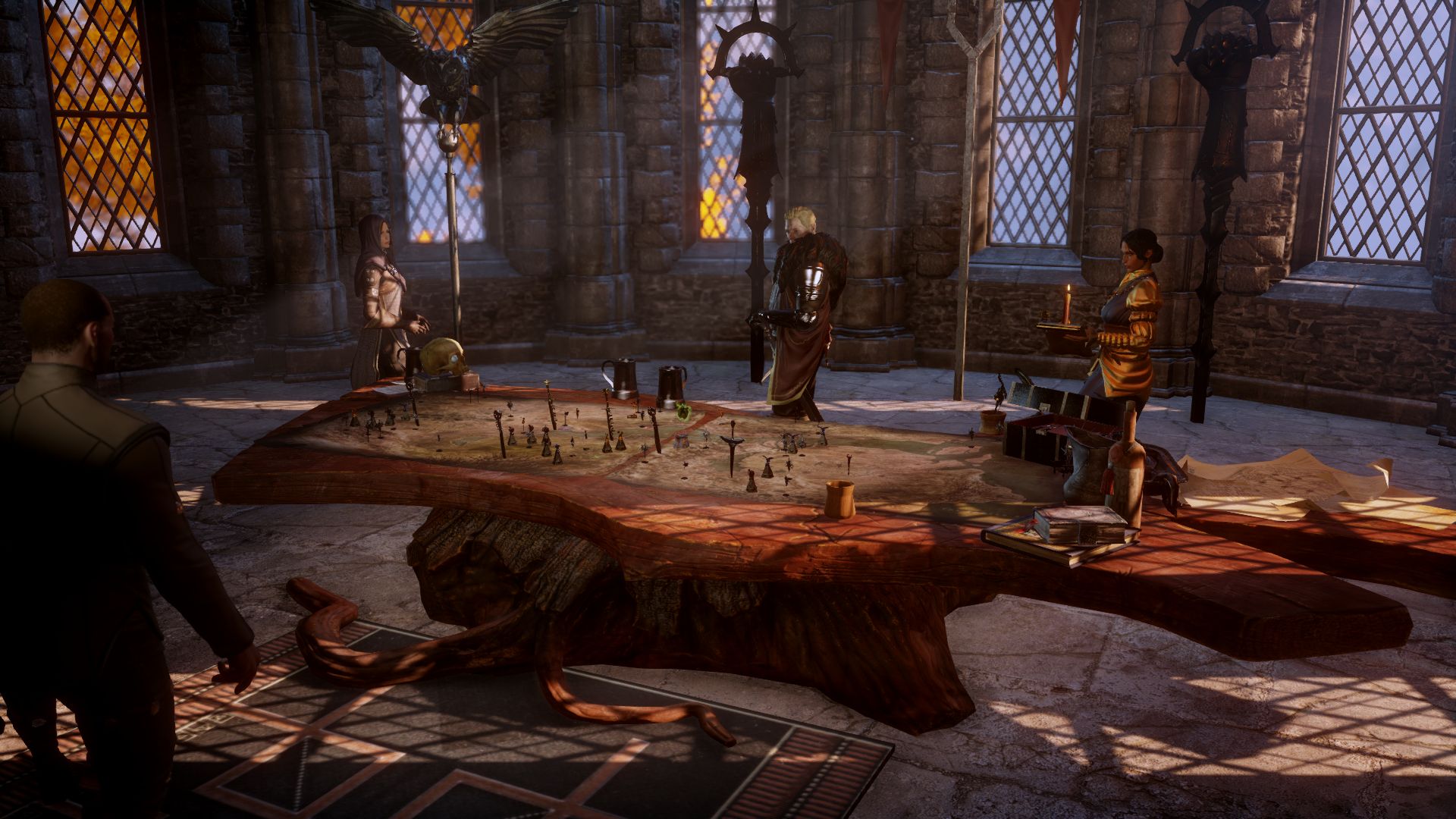
Command your forces and control progression via the War Table
Unlocking the world zones, story missions or commanding forces is done via the War Table. Like the Galaxy map in Mass Effect, the War Table provides an overview of Thedas. As you progress, power gained from completing tasks unlocks zones and story missions. Additional pieces are added to the map as well, yet most represent virtual operations, not visitable locations. You select one advisor to complete each operation and gain appropriate rewards. These are not all separate from the game world, as operations can open quests or vice versa. Some operations collect materials for crafting, so there is less need to spend time hunting for potion ingredients. Linking operations in this way creates a compelling reason to pay attention to the entire War Table. Operations might take minutes or hours, and they all occur in real time. So while you are sleeping, your forces are following orders. The War Table is gripping background content to an already mammoth experience.
Skyhold is the massive castle that you call home during the first half of the game. It holds the War Table, companions and the inquisition forces. It evolves as the story marches toward a conclusion; new merchants populate the courtyard and chandeliers are hung in the main hall. You will come to know its structure intimately, just like the Normandy in the Mass Effect franchise. Although large, navigating the castle is brisk with minimal loading, no fall damage and several fast travel points. Skyhold can be customized with a range of items, including a garden, throne and draperies, although most are pointlessly superficial. Instead of different beds, which are only used in a few cut scenes, it would have been better to have item storage, mini-games or a way to change out of the brown pyjamas. While sitting on a custom throne, you can pass final judgement on notable foes that may languish in the dungeon, even if the dungeon keeper thinks the cells are empty. Skyhold is the main place where you interact with recruited companions, each finding a specific area of the castle to call their own. Skyhold is a great home, and comparing it to camp fire in the first game is a good example of the increased scale for this sequel.
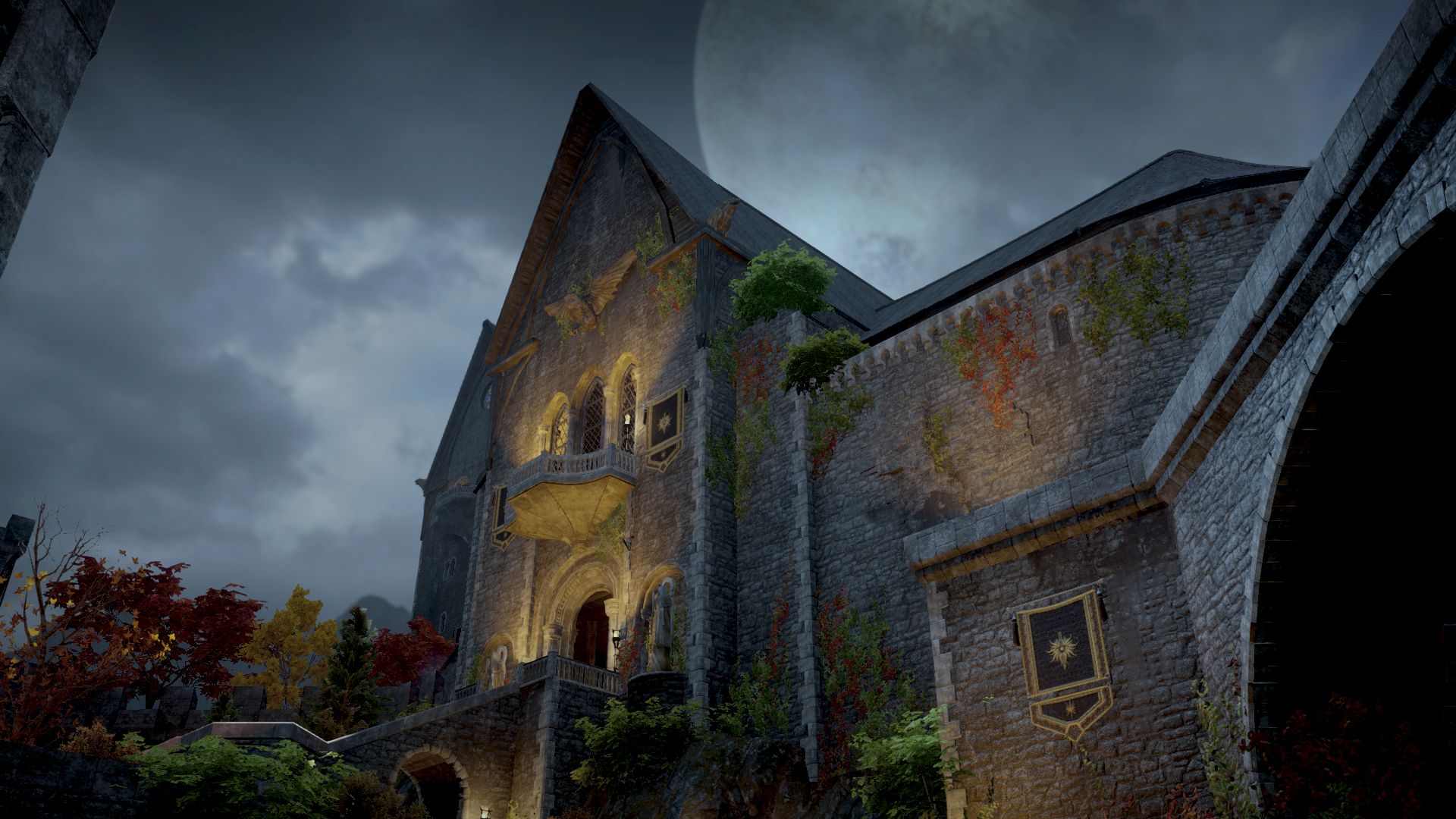
Welcome home, Inquisitor
No BioWare game would be complete without a strong focus on a cast of unique characters. When compared to the developer's previous games, there seems to be a better distribution of dialogue. Nine companions and three advisors each have important story arcs that culminate into specific missions. Companion variety is excellent, from the driven warrior Cassandra to the comedic mage Dorian. You can bring any three companions on your adventure, and they will interact in interesting ways, despite shyness during important situations. Before delving into the inner lives of these characters, you might need to win their approval. Winning the favour of companions is difficult given their diverse motivations and backgrounds. Selecting certain dialogue choices will make some characters dislike you, and consequently eliminate conversation options and side activities. This disapproval can be placated by talking to each character individually, but concentration is needed to avoid making things worse.
Companions can be sated by doing quests important to each character. These might be as simple as interacting within Skyhold or finding Lyrium deposits across numerous zones. Some are multi-step, and involve War Table operations before taking you to an inaccessible corner of larger zones. In most cases the companion mission structure is more natural than BioWare’s recent efforts, and there is a gradual trickle of objectives as quests are spread into more difficult areas. The effort pays off though, as there is satisfaction when you begin to care and see them react. You are rewarded with BioWare’s silky dialogue in the personal cut scenes. It is hard to not get excited when the camera fades into a cut scene, especially compared to the conversation camera that is never close enough.
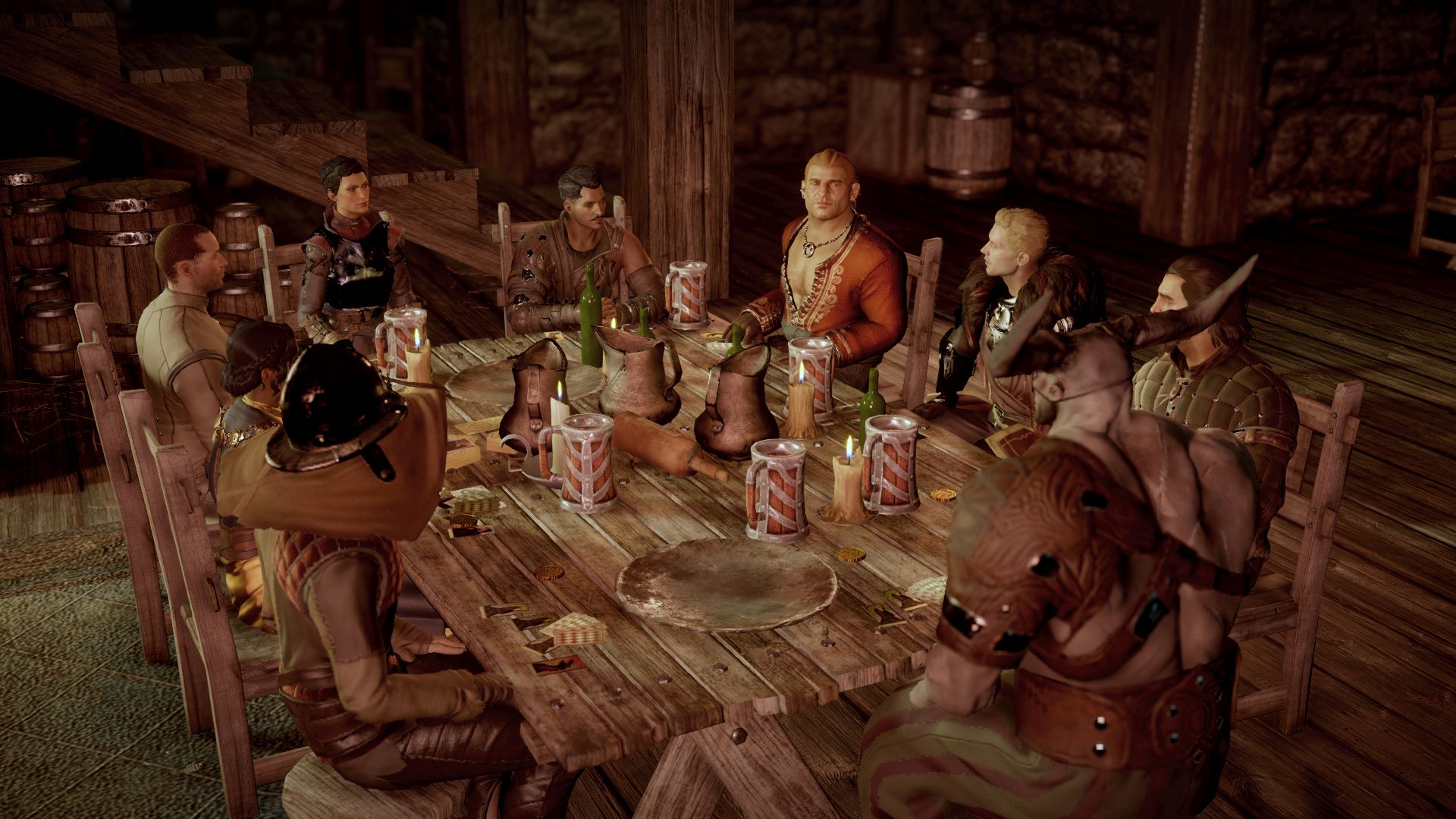
Cut scenes offer incredible exchanges with fantastic characters
At some point, the companions will run out of things to say. You are never told when the conversation options are exhausted, so you frequently loop through every companion just to check they are not hiding a cut scene or more dialogue. This rhythm is typical of BioWare, but perhaps a subtle hint would reduce unnecessary visits. The ending arc for some characters is less than adequate, and one romance option has just a single major romantic scene after you spent hours trying to win their affection. It is a pity that companions go quiet after they become great friends, but forgivable given the amount of dialogue spread throughout. These relationships should have employed more unexpected reciprocation too, which would have made it less about hunting for dialogue. One good example was a late night card game with companions, and although a little rigid, it was the missing link that the game needed more of. Despite these minor flaws, the weighty interaction with companions often takes precedence over saving the world.
When you are not traipsing around Skyhold, or overseeing operations at the War Table, you will be travelling through world zones that are much larger than they first appear. The world design is exceptional for an RPG with this much narrative depth. The zones are littered with areas of interest, so just like Skyrim it is easy to go off on a tangent and forget your previous goal. Vibrant colors and stellar lighting bring areas to life, whether it is the canyons of the Western Approach or the battlements in the Exalted Plains. The panoramic views are jaw-dropping, so explorers will receive frequent visual rewards. The engine that powered Battlefield 4 is able to flex its muscles with fantasy themes that take players through wondrous locales and conjure magical effects. Four years in development has been time well spent when the world zones are of this technical and artistic quality.
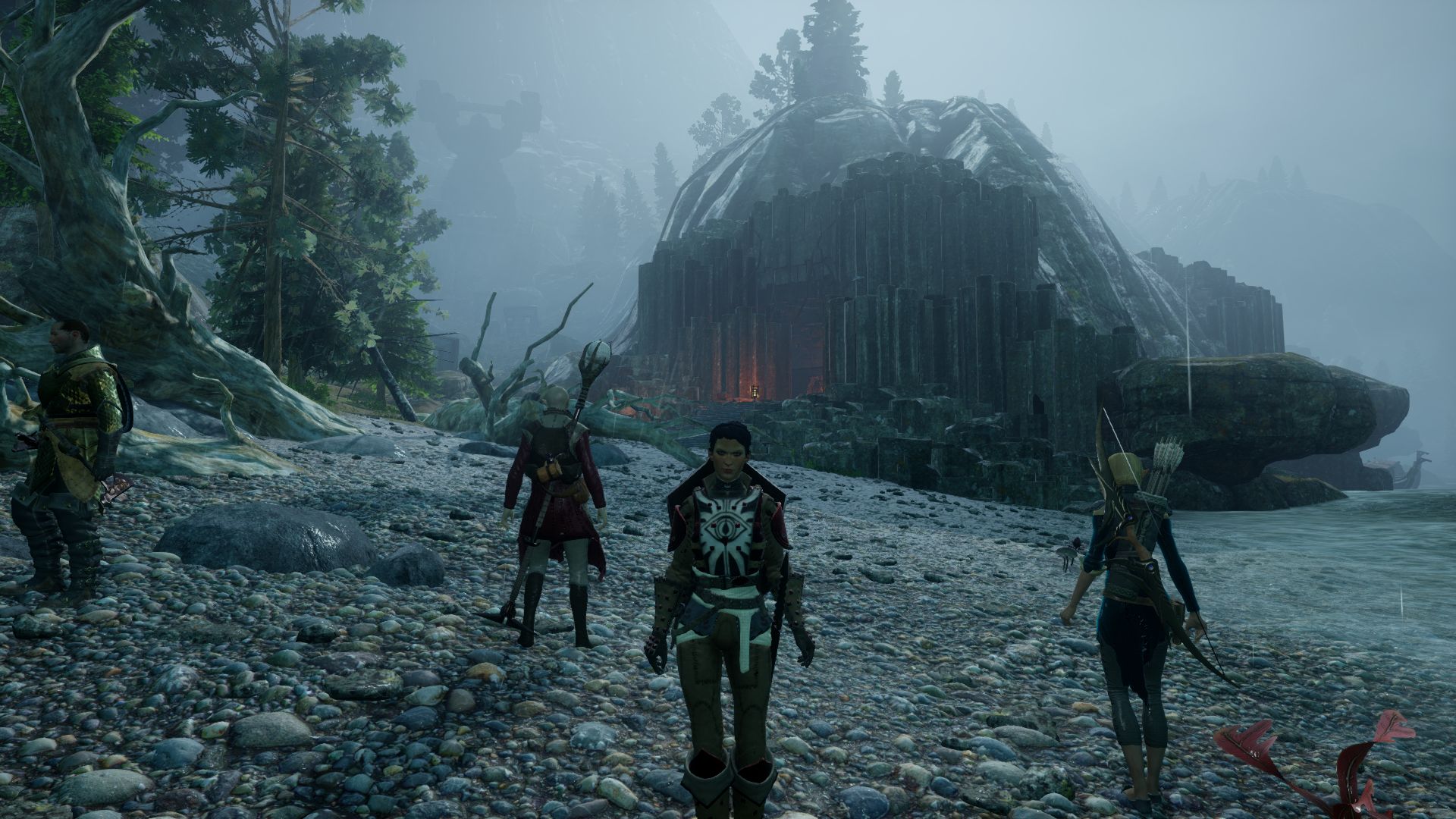
There is no shortage of detail within the huge landscapes
Combat is a mixture of the mechanics from the previous two games in the series. This means there is tactical combat, from Origins, and the more action-orientated approach from the sequel. Switching to tactical combat freezes the battle and gives you advantages that cannot be attained by fighting in real time. If a dangerous foe telegraphs a particular attack, pause the game and command your warriors to raise their shields; this prevents health loss and allows you to venture further without needing to return to camp and restock on potions. Before a battle, order your rogue to hold an elevated position and use your mage to cast a protective barrier. If a fight is getting out of control, pause the action and swoop through the battle to see where it is going wrong.
The pure action components are also good, as you feel every block and see every spell effect. You can knock foes off ledges, drop caltrops to slow aggressors and avoid projectiles. The competent AI changes targets or flanks when appropriate, they will even call out when a party member is in trouble. Despite this intelligence, their propensity to bathe in a dragon fire encourages tactical mode or character switching. The merger between the action and tactical mechanics proves highly successful for somebody who found the combat in Origins distasteful filler. This is not the only reason why combat is better balanced with the story. The density of enemy encounters is looser and battles can be circumvented or abandoned. Story missions can feature more regular action, so exploring after each major event is advised. You can dictate when and where the action occurs, largely because of the world design, and this is the biggest improvement for the combat.
Camera issues are a nuisance when playing in either action or tactical mode. In action mode, the camera does not aim high enough into the sky, most troublesome with elevated Fade rifts or Dragons circling above. In tactical mode, the camera collides with trees, walls and fences because it is locked to navigation paths. Rather than getting the perfect view alongside castle battlements, the camera is restricted to a something far less optimal. Enclosed areas exacerbate the issue as you fight the geometry more than enemies. It just means it takes longer to perform simple tasks, which is no disaster when the time is frozen during tactical battles. If the camera could move through solid objects, and the angles were not so restricted, it would negate most of these problems. Thankfully these camera issues can be easily tolerated under the weight of the entire campaign.
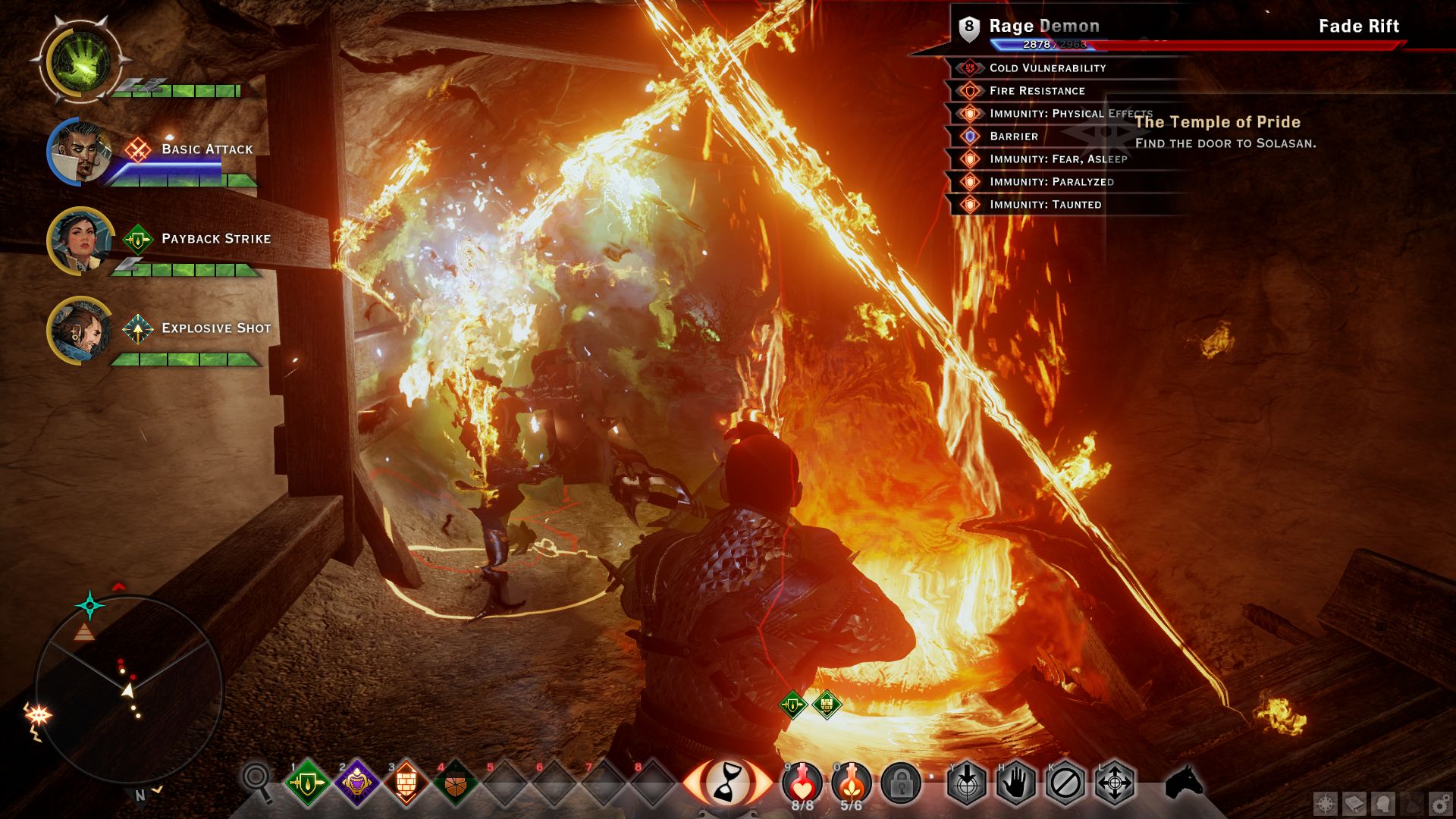
Enclosed areas can get messy during tactical combat
Even though the campaign has more than enough content, BioWare have included co-operative multiplayer that is similar to Mass Effect 3 without having it linked to the campaign. The major structural change from ME3, aside from swords and magic, is the jumbled patchwork of level pieces that form unique dungeons each match. Most of the level pieces will be seen after a handful of matches, yet there are surprises after hours of play. Randomized objectives also try to provide variety, asking you to protect a whiny archer or secure weapons, but they get old fast and do not change the mechanics appreciably. Various side rooms can only be opened by a specific class, encouraging class diversity and making all players feel useful. Gold collected can be used to purchase treasure chests containing randomized weapons, potions or even other characters. Armor and weapons can be crafted or improved, adding a layer of investment as you build each character.
The online experience is not consistent though, with some technical issues reappearing across online sessions. Player movement is generally poor; with mild cases of rubber-banding that might be familiar if you played Battlefield 4 online. Constantly jumping through levels usually provided better movement at the expense of a sore thumb. Joining some lobbies failed completely, kicking me out of multiplayer, and other sessions ended just as the match was starting. Rare cases of treasure urns not breaking was a visual indication of commands not syncing and this led to other issues like spectator camera breaking or zone keys not dropping. Some matches progressed without issue, but you may come across technical problems after a few sessions.
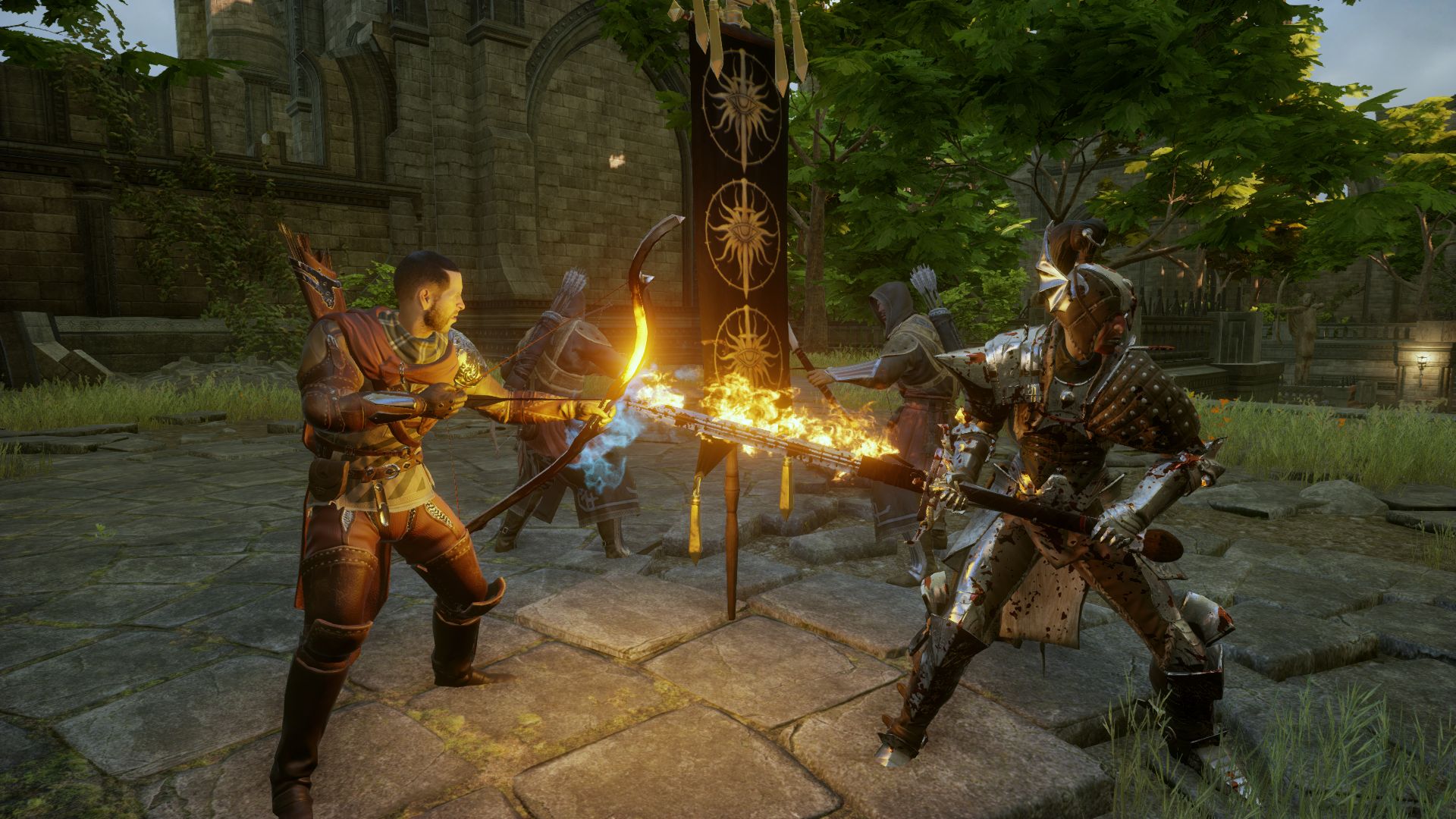
Completing multiplayer levels will reward you with bonus gold
Even without technical issues, the multiplayer is rather bland and clunky. As a warrior you will brush against enemies that ignore you, and network delays make sword battles uncomfortable. Mages cast area spells, but doing so without the tactical pause is clumsy. If you are playing with higher ranked characters, you will feel like a third wheel. The awful party banter frequently overlaps, with some characters exclaiming how much they have learnt before the action started. Although BioWare plans to release more maps, there is minimal reason to play online when the single player is superior and more replayable. Perhaps multiplayer could have rewarded players with items that could be used in the campaign, like crafting materials or weapons, just like the War Table operations they emulate. If the multiplayer characters were at least interesting or funny, like those in the campaign, it may have been enough to keep you playing. The multiplayer needed more incentive to successfully pull you away from the spectacular campaign.
Dragon Age: Inquisition is a masterpiece that uses story, world and characters to create a truly enchanting single player adventure. The narrative is colossal as you deal with major issues across the land of Thedas before making key decisions that frame the narrative. World zones are gigantic, facilitating hours of exploration and overwhelming you with objectives. But it is the characters, predominantly the excellent companions, which glue the entire experience together and draw attention for dozens of hours. This is a game that will linger in your mind between gaming sessions as it consumes your world. Dragon Age: Inquisition is an extraordinary adventure that is impossible to forget, what a shame it has to end.
 Comments
Comments




















